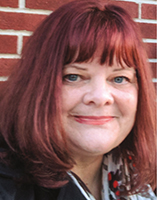
Profile: Michelle R. Saylor
From Modest Start to Model Leader
BY PAUL RIEDE/School Administrator, August 2018

|
| Michelle Saylor |
MICHELLE SAYLOR GREW up in rural Bushkill Township in eastern Pennsylvania. Her father, a union painter, and her stay-at-home mom encouraged her to value education. Unfortunately, her school often didn’t.
“There were times when I was told by the school counselors or teachers that I wouldn’t amount to anything,” she says. “I was poor — therefore I was not smart. Advancing my future, as far as education goes, was not in the picture.”
Saylor graduated from high school, got married at 17 and had the first of her three children at 19. She worked a variety of jobs — secretary, phlebotomist, factory worker and shifts in “every fast-food restaurant you could name.” She didn’t go to college until her early 30s.
In retrospect, it was all excellent preparation for her current job — superintendent of the 2,700-student Bellefonte Area School District in the geographic center of Pennsylvania, 15 miles northeast of Penn State University in State College.
Saylor, 56, rose to the top post from the assistant superintendency in July 2016. She has quickly made her mark. In April, she was honored as one of Education Week’s 2018 Leaders to Learn From.
The superintendent describes Bellefonte as diverse in its own way, with a mix of poor, middle-class and upper-middle-class families. It split down the middle in the fractious 2016 presidential election. But it is racially homogenous, with a white student enrollment of 97 percent.
Saylor sees those demographics as posing opportunities to celebrate differences while bringing people together. Her experiences in school and in her early work life gave her the skills — and credibility — to forge relationships across the district.
“She’s seen a lot, she’s experienced different positions in life and she relates well with students at all levels because of that,” says school board president Rodney Musser.
Saylor developed a workshop for faculty and staff last year titled “Bridging the Socio-economic Divide.” It was part of an ongoing, districtwide conversation that she says is “taking a deep look at the stereotypes and biases that are associated with students on both sides of the divide.”
She also sees second-language study and travel as ways to learn to appreciate differences.
She would like to see both Spanish and Mandarin taught in Bellefonte from kindergarten through 12th grade. She hired two Chinese graduate students as teachers and introduced Mandarin in the poorest of the district’s four schools. Mandarin is taught in K-3 in that school and in 6-12 throughout the district, along with Spanish and French.
Saylor, an extensive traveler herself, encourages international trips for students and teachers.
She and her staff are working to get to a lot of other places, too. The district has launched a one-to-one technology program and in 2017-18 ran 18 AP classes and 16 college-in-the-classroom courses. Through career and technical experiences beginning in 9th grade, students can graduate with multiple industry certifications from any of 18 program areas.
“I really firmly believe, and perhaps my life growing up has colored that belief, that nothing is impossible and it’s not necessarily about financial resources,” she says. “Sometimes I think it’s about our ability or inability to innovate and be creative, and collaborate and pull more people into the conversation.”
PAUL RIEDE is a freelance education writer in Syracuse, N.Y.
BIO STATS: MICHELLE SAYLOR
Currently: superintendent, Bellefonte, Pa.
Previously: assistant superintendent, Bellefonte, Pa.
Age: 56
Greatest influences on career: My first superintendent pushed me outside of my comfort zone. She saw things in me I did not see in myself.
Best professional day: Two come to mind. After I had been superintendent for a few months, a teacher came up to me and thanked me for giving them the opportunity to “teach again.” The other was when an employee’s spouse thanked me for giving that person back their dignity. Both help me realize why each of us must make a difference in the lives of others.
Books at bedside: Primal Leadership by Daniel Goleman, Richard Boyatzis and Annie McKee; and
The 5 Languages of Appreciation in the Workplace by Gary Chapman and Paul White
Biggest blooper: As an assistant principal, I sent an e-mail meant for administrative colleagues to a parent. I definitely learned a lesson about e-mail and double checking before pressing send.
Why I’m an AASA member: The network of support available through my AASA colleagues and the access to information that is relevant and timely.